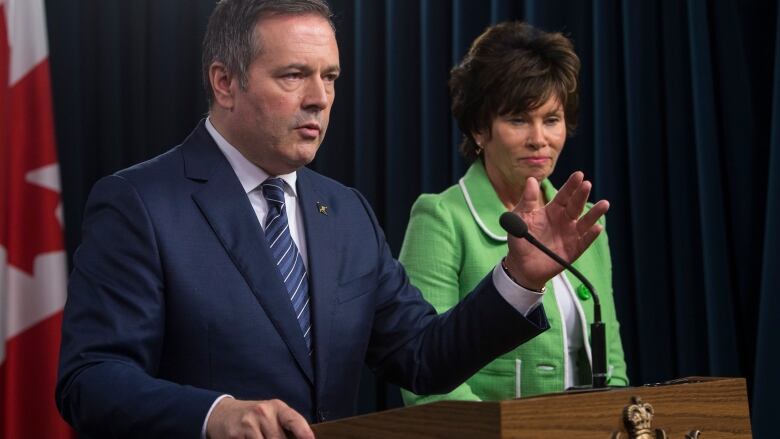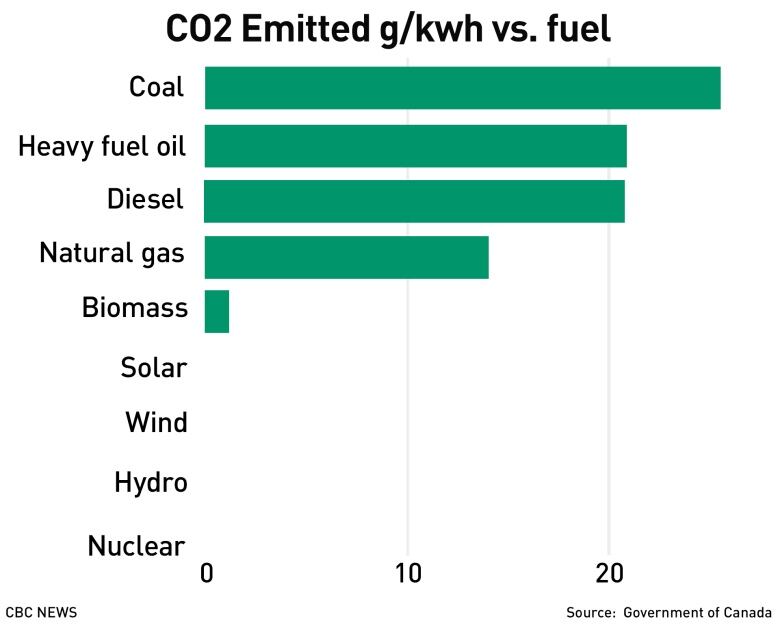Alberta signs on to help develop nuclear reactor technology
Province joins Ontario, Saskatchewan and New Brunswick in agreement on small modular reactors

Alberta is joining three other provinces to support the advancement and deployment of nuclear energy throughsmall modular reactors (SMRs).
Premier Jason Kenney announced Friday that his United Conservative government will sign on to an existingmemorandum of understandingwithOntario, Saskatchewan and New Brunswick.
In a pre-taped statement with Energy Minister Sonya Savage, Kenney said the province hopes the nuclear technology will allow the government to provide power to remote communities, diversify the economy, create jobs and reduce greenhouse gas emissions.
"This will help Alberta stay at the forefront of the latest development in SMR technology, and ensures that we have the appropriate regulatory framework in place, should private industry decide to pursue it in the future," Kenney said.
The Canadian Nuclear Association issued a statement Friday saying Alberta's involvement in developingnuclear energy means "another key window of emission-reducing technology comes into play."
"The potential to harness clean electricity and heat to further accelerate emission reductions could be highly impactful to the Albertan and Canadian economies and to our ability to achieve net zero by 2050," said the association's president, John Gorman.
SMRs vs. traditional nuclear reactors
Traditional nuclear reactors used in Canada can typically generate about 800 megawatts of electricity, or about enough to power 600,000 homes at once (assuming one megawatt can power about 750 homes).
SMRs, on the other hand, can generatebetween 200 and 300 megawatts.
The technology is also small enough to be transported on a truck, ship or train, and has been touted by the federal government as safer than traditional nuclear reactors.

SMRs are designed to produce less nuclear waste than larger reactors, but waste disposal remains an issue.
Canada doesn't yet have a permanent nuclear waste repository, although the Nuclear Waste Management Organization is currently working to select a site.
Waste concerns
Theresa McClenaghan, executive director of the Canadian Environmental Law Association, told CBC New Brunswick in December 2019 that this factor along with national security makes the technology too unpredictable.
"You're still creating radioactive waste," said McClenaghan.
She said having more reactors, especially if they're in rural areas, means there's a greater chance that waste or fuel from the reactors could be stolen for nefarious purposes.
"You'd be scattering radioactive materials, potentially attractive to diversion, much further across the country."
Savage acknowledged safety concerns during the announcement.
She said appropriate safety measures would be put in place, and the technology would besubject torigorous federal and provincial environmental approval processes.
"Safety is always our No. 1 priority and although they're still early in their design, SMR researchers have reiterated that the smaller scale, in terms of both power output and physical size, helps to mitigate the risk," Savage said.
Canada's SMR Roadmap
Natural Resources Canada announced it would be exploring the application and commercialization ofSMRsin 2018, when it launched theCanadian Small Modular Reactor Roadmap.
The federal government has said nuclear innovation playsa "critical role"in reducing greenhouse gas emissions as Canada moves toward a low-carbon future.
Ontario Premier Doug Ford, Saskatchewan Premier Scott Moe, and New Brunswick Premier Blaine Higgs committed to collaborate on developing SMR technology in 2019.
At the time, the leaderssaid it could be an opportunity for economic growth, estimating the Canadian market for this energy at $10 billion and the global market at $150 billion.

But the technology is still evolving; Minister Savage acknowledged thatit isn't expected for a decade or so.
"This is still an emerging technology. It's in its early stages of design and development," Savage said.
"While timelines are different on a lot of things we think they could be available globally within 10 years."
Alberta rich in talent and uranium, Savage says
According to Savage, there are several reasons why Alberta is an ideal place to develop and explore SMR technology.
She said the province has a long history of responsible energy development, a respected research sector, a highly skilled workforce, and an established regulatory system.
And Alberta also has uranium lots of it, Savage said.
"Many people are probably not aware that Alberta is also home to one of the greatest uranium resources in the entire world," Savage said.
"The Athabasca basin straddles the northern Alberta-Saskatchewan border, and has a reliable and enormous supply of fuel for these types of reactors."
Nuclear energy industry 'wanted Alberta,' expert says
The announcementdid not come as a surprise to Duane Bratt, a political science professor at Mount Royal University and author ofCanada, the Provinces, and the Global Nuclear Revival.
He attended the CNA's annual conference in February, where he said intentions to expand thememorandum of understanding beyond the first three provinces were made clear and Alberta was first on that list.
"All of them were looking for Alberta to join, because of the mix of resources Alberta has, the role that it plays in other forms of energy development they wanted Alberta on side," Bratt said.
According to Bratt,conversations about harnessing nuclear energy to bolster the oilsands have been unfolding for over a decade in Alberta.

Traditional nuclear reactors were eventually determined to be unsuitable, but SMRscould change the game because of their size.
"There was a lot of discussion about traditional nuclear reactors being deployed in the oilsands in sort of the 2007 to 2011 period, to produce steam as part of this process to get bitumen," Bratt said.
"They realized that conventional nuclear [energy] didn't work very well in the oilsandsSMRs are very different, because they're smaller, which means that they can be used in the oilsands much better."
Project could unite Kenney, Trudeau on energy
Integral to the project, Bratt said, will be the involvement of the federal government.
It was Prime Minister Justin Trudeau's government that developed the roadmap to explore SMRs as a way to reduce carbon emissions, Bratt said and so, the project could result inKenney and the Liberals working as a team in the energy sector.

"The key is going to be the commercialization of reactors, and that is why this is going to require a partnership not just between the provinces, butthe federal government and the industry as well," Bratt said.
"I think this is positive for federal-provincial relations. This is an energy area that the Kenney government could work with the federal government on, not just like-minded provinces."
COVID-19, oil slump prompts need to diversify
This all comes on the heels of a tough slogforAlberta, economically.
The province's economy has been pummelled since the global oil price crash in 2014, and has seen its projected deficit balloonto over$20 billion in the wake of the pandemic.
In his announcement, Kenney said his intention is to explore every option in the hopes of sparking a reversal of fortune.
"As we continue to take actions to support Alberta's economic recovery to get past the COVID crisis, Alberta's government promises to explore all opportunities that could diversify our economy and create jobs," he said.
With files from Emily Chung, Elise Von Sheel, Rick Donkers, Drew Anderson and Jordan Gill












_(720p).jpg)


 OFFICIAL HD MUSIC VIDEO.jpg)
.jpg)



























































































